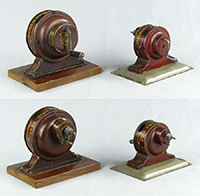 |
||||
|---|---|---|---|---|
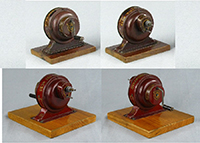 |
Dynamobil, 1st Generation large size, circa late 1890s – early 1900s Shown are two of the first generation Dynamobil motors. These featured cranked flywheels for momentum to drive accessory workshop tools. The dark red example at top is the earliest noted by oiling holes and a smaller wooden base. The brighter red example is a little later production as oiling holes have been removed. Both examples are equipped with push-pull type clutch devices to start and stop the pulley from engaging the flywheel drive. Both of these pieces utilize lithography and painting to decorate. Dark red example is marked “Dynamobil”, “Orig. Hess”, “D.R.G.M.”, “JLH” logo and “H” shield logo. The brighter red model is marked “Dynamobil”, “Pat. Hess”, “JLH” logo and “H” shield logo. These early models used screws to fasten the motor to base with later models using nails. |
|||
.jpg) |
Dynamobil 1st Generation Changes (large size) There are many small and subtle changes within the first generation of Dynamobils. Here are some noticeable differences: Early models use screws for both motors and accessories to fasten to board; later models use nails. Early model twin drop hammer used cast metal hammerheads and finials; later models use lithographed tinplate. Early model rotating mills used orange and red litho; later models used gray and red. Early model trip hammers were in red litho; later models use gray litho. Early motors used a combination of litho and paint in maroon red; Later models were all litho in red, then in gray. Early motors used a push-pull type clutch to engage motor with accessories; later models used a lever type clutch. |
|||
 - Copy - Copy - Copy.jpg) |
||||
 |
A cutaway of the Hess Dynamobil showing it's internal gears and flywheel. | |||
Dynamobil 1st Generation, Small and Large models, circa late 1890s – early 1900s |
||||
 |
Dynamobil Color Change for 1st Generation, circa 1920s Dynamobil body colors were changed for both the large and small models during the first generation. The large size went from red to gray, the small size went from red to green. |
|||
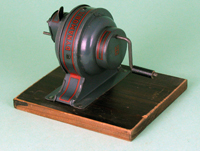 |
This first generation Dynamobil’s body color has been changed to gray and oiling holes removed. The push-pull clutch has also been replaced with a lever type clutch actuator. | |||
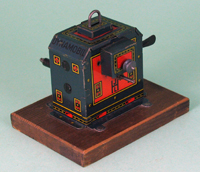 |
The newly designed second generation Dynamobil was also made in the smaller size. Graphics were not totally identical, but the small size greatly resembled big brother. | |||
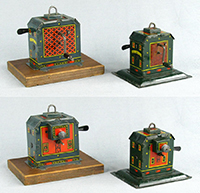 |
Dynamobil 2nd Generation, Small and Large Models, circa 1920s The newly designed second generation Dynamobil had its exterior shape and graphics modernized with bright color and a new more industrial shape. These were produced in two different sizes, with shape and graphics being almost identical. |
|||
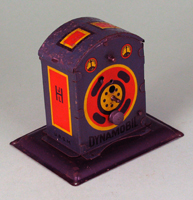 |
The third generation Dynamobil had new graphics outside plus a slightly changed shape, but the big changes were the inside mechanics. One of the problems with first and second generation Dynamobils was that they could be cranked in both directions. This would have been OK except that the Dynamobil accessories being powered would not always work in two directions. It was also very easy to strip gears in the two generations preceding. The new mechanics only allowed cranking in one direction and also acted in more of a synchronized way when engaging the crank. It was a great mechanical improvement that was also carried into the flywheel motors powering the Hessmobils of the time. | |||
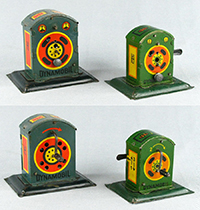 |
Dynamobil 3rd Generation, Small and Large Models, circa late 1920s to early 1930s The third generation Dynamobil had new graphics outside plus a slightly changed shape, but the big change was the inside mechanics. First and second generation Dynamobils could be cranked in both clockwise / counterclockwise directions, however the accessories would only function when cranking in a clockwise direction. The third generation solved this problem by only allowing clockwise cranking. Previous generation Dynamobils also had a problem with gears stripping when too much pressure was applied when cranking. The new mechanics acted more in a synchronized manner which greatly helped with gear stripping. These new mechanics were also carried over to the flywheel powered Hessmobils of the period.
|
|||

